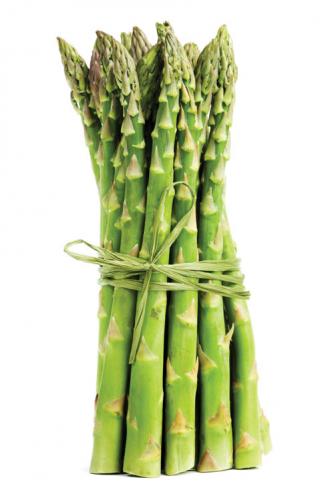
Michigan Fresh: Using, Storing, and Preserving Asparagus (HNI28)
DOWNLOADJuly 10, 2023 - Lisa Treiber, Michigan State University Extension
This Document is offered in: English, Arabic
Food Safety and Storage
- Wash hands before and after handling fresh produce.
- Keep asparagus in the refrigerator away from meat, poultry and seafood products.
- Wash asparagus under cool running Do not use soap.
- Keep asparagus away from raw meats and meat juice to prevent cross-contamination.
- For best quality and nutritive value, preserve only what your family can consume in 12 months.
Yield
|
1 pound (snapped) = |
2 cups cut up |
|
1 to 1½ pounds fresh = |
1 pint frozen |
|
2½ to 4 pounds fresh = |
1 quart canned |
|
10-pound box = |
7 to 10 pints frozen |
|
24½ pounds = |
a canner load of 7 quarts |
|
16 pounds = |
a canner load of 9 pints |
|
1 crate (31 pounds) = |
7 to 12 quarts canned (average 3½ pounds per quart) |
|
1 bushel (45 pounds) = |
30 to 45 pints frozen or 11 to 18 quarts canned |
How to Preserve
Freezing
Frozen asparagus retains both color and flavor better than canned asparagus. Select young, tender stalks with compact tips. Wash thoroughly and sort according to thickness of stalk. Cut off and discard any tough portions of stalks. Leave spears in lengths to fit the package or cut into 2-inch lengths. Blanch in boiling water, 2 minutes for small spears and 2-inch asparagus lengths, 3 minutes for medium spears and 4 minutes for large spears. Cool promptly in ice water for the same length of time you blanched the asparagus. Change water as it becomes discolored or begins to warm up.
Pack into airtight freezer containers or bag, leaving no headspace. When packing spears, alternate tips and stem ends. In containers that are wider at the top than at the bottom, pack asparagus with tips down. Seal, label, date and freeze the product. Alternatively, freeze individual spears on a cookie sheet or tray. When frozen, pack spears in freezer containers or bags and remove as much air as possible. Seal, label, date and freeze.
Canning
Pressure canning is the only safe method of canning asparagus. Asparagus must be pressure canned to avoid the potential of the foodborne illness botulism (unless preparing a pickled asparagus recipe).
Select young, tender, tight-tipped spears, 4 to 6 inches long. Wash asparagus and trim off tough scales. Break off tough stems and wash again. Leave asparagus in spears or cut into 1-inch pieces.
- Raw pack method: Pack raw asparagus into hot jars, leaving 1-inch headspace. If desired, add ½ teaspoon salt per pint, or 1 teaspoon salt per Fill jars with boiling hot cooking liquid or water, leaving 1-inch headspace. Remove air bubbles; adjust headspace if needed. Wipe jar rims with a clean paper towel, adjust lids and process (see tables that follow for recommended processing times).
- Hot pack method: Cover asparagus with boiling water. Boil 2 or 3 minutes. Pack hot asparagus into hot jars, fill jars with boiling hot cooking liquid or water leaving 1-inch headspace. Add ½ teaspoon salt to pints, 1 teaspoon to quarts, if desired. Remove air bubbles; adjust headspace if needed. Wipe jar rims with a clean paper towel, adjust lids and process (see tables that follow for recommended processing times).
|
Recommended process time (in minutes) for asparagus in a dial-gauge pressure canner |
||||||
|
|
Canner Pressure (PSI) at Altitudes of |
|||||
|
Style of pack |
Jar size |
Process time |
0 – 2,000 ft |
2,001 – 4,000 ft |
4,001 – 6,000 ft |
6,001 – 8,000 ft |
|
Hot and raw |
Pints |
30 |
11 lb. |
12 lb. |
13 lb. |
14 lb. |
|
Quarts |
40 |
11 lb. |
12 lb. |
13 lb. |
14 lb. |
|
|
Recommended process time (in minutes) for asparagus in a weighted-gauge pressure canner |
||||
|
|
Canner Pressure (PSI) at Altitudes of |
|||
|
Style of pack |
Jar size |
Process time |
0 – 1,000 ft |
Above 1,000 ft |
|
Hot and raw |
Pints |
30 |
10 lb. |
15 lb. |
|
Quarts |
40 |
10 lb. |
15 lb. |
|
Let jars sit undisturbed for 12 to 24 hours, check lids to be sure they’ve sealed, remove rings, wash jars, date, label and store. Food in jars that do not seal must be reprocessed in a clean jar with a new lid within 24 hours, refrigerated or frozen.
Tables were adapted from the Complete Guide to Home Canning: Guide 4: Selecting, Preparing and Canning Vegetables and Vegetable Products, USDA, 2015, p. 5. https://nchfp.uga.edu/publications/publications_usda.html#gsc.tab=0.
References
- Andress, E., & Harrison, J. A. (2014). So easy to preserve (Bulletin 989). (6th ed.). University of Georgia Cooperative Extension.
- U.S. Department of Agriculture. (2015). Complete guide to home canning (Rev. ed.). (Agriculture Information Bulletin No. 539). http://nchfp.uga.edu/publications/publications_ usda.html
More information



 Print
Print Email
Email